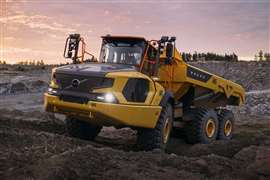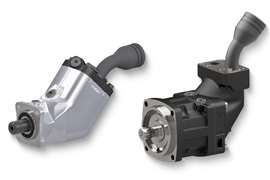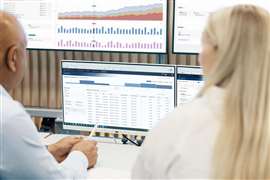Read this article in Français Deutsch Italiano Português Español
Industry experts talk hydrogen for rail
16 April 2025
Railway applications are among the many being investigated for hydrogen fuel cell power. Hydrogen (H2) fuel was on the agenda at the recent Smart Rail Innovation Conference hosted by the nonprofit Canadian Urban Transit Research & Innovation Consortium (CUTRIC). In one session, several industry experts discussed the viability of fuel cells in driving sustainable rail in Canada.
“Hydrogen-powered rail is emerging as a very promising solution for decarbonizing not just Canada’s transportation sector but across the globe, particularly for regions where electrification is not feasible or cost-efficient,” said Maike Althaus, executive director of Hydrogen Ontario and moderator of the session.
Decarbonizing in Canada
Alexandre Lampron is director of strategies and development for Hydrogène Québec, a non-profit organization focused on developing the hydrogen ecosystem in the Canadian province. He set the stage by addressing Québec’s decarbonization goals.
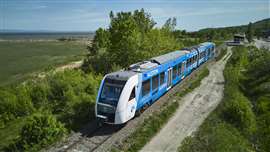 Alstom’s Coradia iLint, which the company said was the first hydrogen-powered passenger train in North America. (Photo: Alstom)
Alstom’s Coradia iLint, which the company said was the first hydrogen-powered passenger train in North America. (Photo: Alstom)
“Québec is working on several decarbonization objectives,” he said. “A reduction of GHG (greenhouse gas) emissions — target of -37.5 percent by 2030 and carbon neutrality by 2050. It’s tomorrow.”
The GHG goal references 1990 levels. Lampron said that at that time, transportation amounted to nearly 44 percent of GHG in Québec. Current government data puts that percentage today at 39 percent.
Québec’s objectives mirror those of Canada at large, including net-zero emissions by 2050 as part of the country’s Net-Zero Emissions Accountability Act.
Lampron said Québec’s decarbonization goals are supported by the province’s Green Hydrogen and Bioenergy Strategy 2030, which was unveiled in 2022. The strategy aims to reduce the use of fossil fuels across a variety of sectors, including rail, by replacing them in part with green hydrogen.
“The strategy, ambitious but realistic — let’s be honest — sets our guidelines to encourage the production and use of green hydrogen as a replacement for fossil fuels.”
The specific fossil fuel reduction goal is 1 billion liters by 2030, which translates to 16 percent of the 2030 GHG emissions reduction target, Lampron said.
Hydrogen Rail Projects
Lampron addressed a recent H2 rail project in Québec that aligned with the province’s GHG reduction targets: a Coradia iLint hydrogen train made by green mobility provider Alstom and launched in 2023 in Charlevoix, a region of Québec.
In August 2023, Power Progress reported that the Coradia iLint carried its first passengers the previous June and that it was powered by fuel cells provided by Accelera by Cummins. Alstom said the Coradia iLint model was launched at InnoTrans 2016.
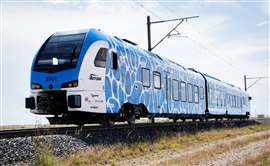 The Stadler FLIRT H2 passenger train, which is going into service in San Bernardino, Calif., under the moniker of ZEMU (Zero-Emission Multiple Unit). (Photo: Stadler)
The Stadler FLIRT H2 passenger train, which is going into service in San Bernardino, Calif., under the moniker of ZEMU (Zero-Emission Multiple Unit). (Photo: Stadler)
Lampron said that the train taught Québec much about fuel cell electric rail. Not only did passengers express curiosity about H2 as a fuel source, but Lampron said many spoke positively about the train’s quiet operation, “because it’s a major advantage over diesel trains.”
Stadler Rail is also exploring H2 in rail applications around the world. One of its more recent success stories is the fuel cell electric FLIRT, which stands for Fast Light Innovative Regional Train. The train arrived in San Bernardino, Calif., last year, awaiting the chance to be put into service by the San Bernardino County Transportation Authority (SBCTA).
“The SBCTA FLIRT H2, or the ZEMU as they call it — Zero Emission Multiple Unit — has just finished its testing period,” said Kaden Killpack, commercial product manager for Stadler Rail. “It’s now ready to go into revenue service, and we’re waiting on final authorization from the Federal Railroad Administration out of [Washington] D.C.”
Killpack explained the design of the FLIRT.
“The FLIRT is a very modular vehicle,” Killpack explained. “We build it with a central power pack, which can be switched for hydrogen, battery power or renewable diesel, in the case of some of our customers.”
Lampron noted that regarding the Coradia iLint, few passengers expressed concerns over the safety of H2 as a fuel source. Killpack echoed that sentiment.
“A very exciting piece of our project has been safety management,” he said. “The vehicles are extremely safe.
Killpack continued, “We work through mitigations for all types of risks using the U.S. military standard 882B, which looks at hazard probability and severity and how we mitigate both the probability and severity to bring things to acceptable risks, and what can we change about our safety-related application conditions to make sure we have the utmost safety on the vehicle.”
Infrastructure Challenges
Althaus noted that despite various projects investigating the viability of H2 for rail, significant challenges do exist.
“The hydrogen value chain is not entirely built out yet, which would be needed to support large-scale operations,” she said.
Particularly, the Coradia iLint hydrogen train laid bare some these challenges.
“So, we’re looking at a lack of hydrogen infrastructure,” Lampron said. “We’re looking also at economic and energy costs. It costs a lot of money right now [compared to] the diesel per kilometer.”
Linde Engineering, via the Linde Hydrogen FuelTech division, is tackling hydrogen refueling for mobility. In 2022, the company’s project in Bremervörde, Germany, produced the first H2 refueling station for trains in the world using compressed gaseous hydrogen (cGH2).
“It was a world first in the respect of being the first hydrogen refueling station that is specifically dedicated to refueling rail transportation,” said Thomas Acher, head of process design and development for Linde.
With a daily hydrogen demand of 1,600kg (1.57 tons), Acher said, “We are fueling 14 hydrogen passenger trains that are on duty in the state of Lower Saxony in the northern part of Germany.”
Like in Québec, the fuel cell electric trains using the station are Coradia iLints.
The station has a maximum storage capacity of 4,590kg (4.5 tons) of hydrogen, which is supplied via trailer.
“But in the next step of this project, it is planned to have hydrogen production nearby that supplies the hydrogen refueling [from] there,” Acher said.
According to Acher, setting up the fueling station was a learning experience.
“Of course, we had the opportunity to take away these learnings and use them for all other hydrogen heavy-duty refueling projects we had afterwards,” he said.
Liquid Hydrogen Fueling
Among those projects is Linde’s latest H2 refueling approach: sub-cooled liquid hydrogen, or sLH2, technology.
“At the moment, this technology is catered to truck transportation,” Acher said of the approach developed in partnership with Daimler Truck. “But we already had [our] first request of adapting it to other forms of mobility, specifically trains, aviation and marine.”
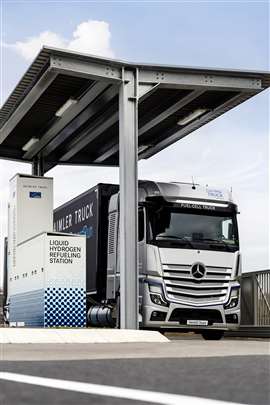 A Mercedes-Benz fuel cell electric truck refuels with sLH2 technology. (Photo: Daimler Truck)
A Mercedes-Benz fuel cell electric truck refuels with sLH2 technology. (Photo: Daimler Truck)
The sLH2 approach means filling a vehicle tank with subcooled hydrogen at a temperature of about -247ºC (-413ºF) to pressures up to 1.6 MPa (232 psi).
“It’s a very simple refueling technology that offers throughput beyond 400 kg per hour with the setup we have already developed and commercialized,” Acher said. “It is significantly beneficial in terms of investment costs and operating costs.”
According to Acher, sLH2 technology solves problems inherent in fueling with gaseous H2 for heavy-duty applications.
“When you base all of this on a gaseous hydrogen supply and gaseous refueling technology, you run into problems,” he said. “From the logistics to begin with, you have to transfer the hydrogen to your station. And at some point, it is logistically unfeasible to do this with gaseous hydrogen, so you have to switch to liquid anyway.”
Acher added that while converting liquefied H2 into its gaseous counterpart for fueling is possible, there are applications where fueling with liquid H2 makes more sense.
“With the step of using liquid directly in the vehicle tank, you can avoid a lot of equipment and a lot of complexity in terms of the process on the station side,” he said. “And this relates to the dramatic degrees of the investment cost. You don’t have to have cooling equipment at the station. You don’t have to have high-pressure storage tanks anymore. This also plays into footprint considerations.”
Finally, Acher noted that cGH2 fueling requires a specific temperature and pressure window outside of which the vehicle’s tank could be damaged.
“This is much more reliable and stable if you go to liquid hydrogen, because the process is much closer to conventional diesel or petrol filling,” he said. “You just press a button, the liquid starts to be transported from the station to the vehicle, and once the vehicle tank is filled, the process stops.”
Linde and Daimler achieved a milestone in February 2024 with the opening of the first sLH2 fueling station. It delivers 400 – 500 kg per hour, with automated fillings lasting between 12 and 15 minutes.
POWER SOURCING GUIDE
The trusted reference and buyer’s guide for 83 years
The original “desktop search engine,” guiding nearly 10,000 users in more than 90 countries it is the primary reference for specifications and details on all the components that go into engine systems.
Visit Now
STAY CONNECTED




Receive the information you need when you need it through our world-leading magazines, newsletters and daily briefings.
CONNECT WITH THE TEAM











